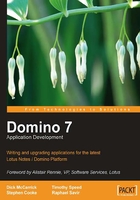
Foreword
Congratulations on investing your time to learn more about Lotus Notes and Domino! This book comes at a key time for Notes/Domino application developers and their organizations.
Since its introduction, Notes/Domino has been a true collaboration platform for businesses. It has uniquely combined collaboration with business applications all within the context of what users are trying to accomplish. A powerful programming platform combined with intuitive tools, it opened up many business ideas and processes to automation through millions of applications, from small personal tools to mission-critical, line-of-business systems. It has also led to the establishment of one of the most creative and largest developer communities in the industry.
A review of Notes/Domino through the years shows how it has revolutionized the way we work. See also the article, "The History of Notes and Domino", published on the developerWorks: Lotus website (www.ibm.com/developerworks/lotus/library/ls-NDHistory). The 35,000 users who adopted Notes Version 1 got the first look at many of the features that we take for granted today, including mail, discussion databases, group directories, customizable applications, Access Control Lists (ACLs), doclinks, encryption, and replication to name just a few. When released, these were all revolutionary new concepts that allowed users to be more productive.
Release 2 focused on scalability issues, allowing Notes to support roughly 10,000 users and accommodate larger enterprises. This release also included enhancements to the application programming interface (API), mail (including return receipt, address look-up, and multiple address books), and additional formula language functionality.
By the time Release 3 was introduced, nearly 500,000 people used Notes. To make the user experience better for the growing user base, Release 3 focused on improving the user interface, further enhancing scalability, as well as incorporating features such as full-text search, selective replication, and support for the Mac client.
With Release 4, the world was introduced to a highly revamped version of Notes, one designed to embrace Internet technology by integrating Notes with the Web. In addition to a completely redesigned user interface, people were introduced to
Internet integration that allowed Web‑browser accessible Notes databases, new messaging capabilities, and the LotusScript programming language.
Release 5 furthered the concept of Web integration, and also gave users a browser-type interface with a customizable Welcome page. For application developers, Domino Designer provided a conducive environment for creating secure applications.
Release 6 represented a significant step towards integrating Notes with the rest of the IBM software portfolio. Two features that customers especially embraced were the integration of Sametime instant messaging into the Notes client, and the ability to access mail from the Web. Enhancements were also made to Domino Designer to make it easier to create applications and reuse code.
With more than 125 million users worldwide, Release 7 of Notes/Domino was notable for many reasons, including significant improvements in the user interface, scalability, and the total cost of ownership. However, the most powerful and important set of changes occurred in the programming model. Capabilities were added to allow Notes applications to utilize Web Services and a relational data store (DB2).
The underlying reason for these changes is very simple: Notes and Domino applications represent a huge investment for customers. It has become critical for applications to be able to be leveraged, integrated, and reused. Increasingly, this means allowing these applications to participate in loosely coupled standards-based architectures. Service-Oriented Architecture (SOA) has become the prevailing term for this type of implementation.
Many customers I talk to do not yet think of their Notes and Domino applications as potential elements in an SOA strategy. I think that is a mistake. This book is a great resource to help you start thinking about SOA, and how it should relate to your Notes environment.
So what's next?
As this book nears publication, Notes 8 (announced with the code name Hannover) is progressing into its first public beta. Many observers have commented on the exponential progress that has been made in the user experience, or the integration of activity-centric computing. These are certainly critical elements and will be a key differentiator for Notes 8. But something deeper lies beneath the surface for application developers. With Notes 8 being based on a Java-based Eclipse foundation, developers have new options. Not only can you continue to run and develop traditional Notes applications (unchanged!), you can start to build composite applications that are enterprise mashups of Java components, .nsf-based applications, data delivered via portlets, or other components that can be hosted within an Eclipse plug-in (such as .Net). Also, for the first time, Notes and Sametime (with Version 7.5) will share a common foundation allowing sharing of application components.
So, everything you have still runs, and you can adopt multiple programming models at your pace. Why does this matter? Because:
- Your existing applications and skills investment are protected and can easily be extended to build a new generation of open applications.
- Notes will provide a rich client for not only Domino, but Portal or Java-based applications. Essentially, Notes will become the client for SOA.
- The Notes development community will have the potential for significant growth as Notes becomes a viable deployment platform for the millions of developers working with Eclipse and Java.
Applications in the context of business processes have never been more important. In some ways, we are coming right back to the original value proposition of Notes.
So Notes is new again. Enjoy this book for what it can help you deliver now and start thinking about what the future can hold!
On a personal note, I'd like to extend my congratulations to the authors. Their collective skill is in constant demand by customers around the world. Writing this book is a labor of love and a huge contribution to the Lotus community.
Congratulations!
Alistair Rennie
VP, Software Services
Lotus